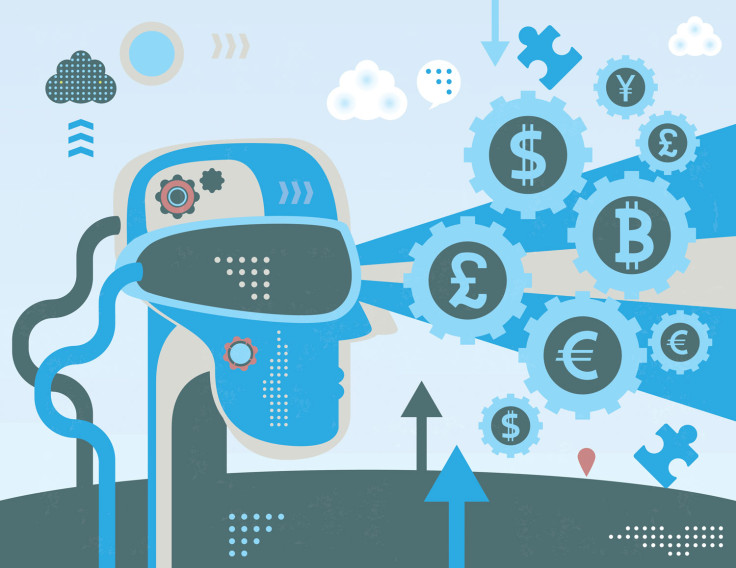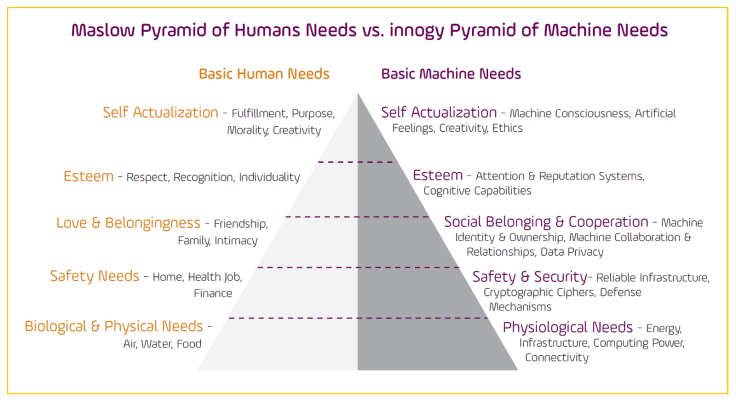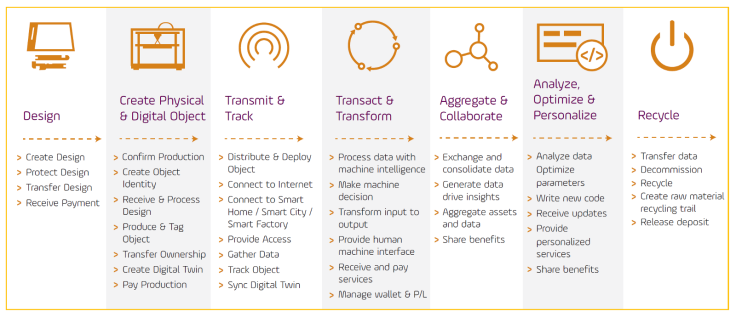When a machine is the customer – designing for machines
Dr. Carsten Stöcker is Senior Manager in the Machine Economy Innovation Lighthouse Lead at innogy SE.

In Texas, a child asks an Amazon Echo to "play dollhouse with me and get me a dollhouse?" and it orders a physical dollhouse for her.
In England, the words "OK Google, what is the Whopper burger?" in a Burger King advertisement trigger Google Home smart speakers to start spouting descriptions of the burgers.
And sometime soon, your car may choose the best price for maintenance or an electric charge, as well as driving itself to the appointment.
Welcome to the new world where intelligent machines, rather than people, make more and more decisions about what to buy, at what price, and complete the transactions without a middleman over a blockchain distributed ledger. This will mean massive new markets for everything from home supplies ordered via "smart speakers" such as Amazon Echo to electricity ordered by smart thermostats to replacement parts and raw materials purchased by manufacturing robots or optimisation algorithms for cyber physical systems of machines.
These developments will also create "algorithmic profits" through transaction fees charged by the software that matches buyers and sellers or aggregates the needs of machines.
For instance, in a renewable powered electricity grid "volatility of energy supply" is a key issue. The grid control system needs to match feed-in and consumption of electric power in real time. In other words the grid control system has an urgent "physiological machine need" to get access to flexibilities such as batteries to store excess energy or request delivery of energy. Algorithms aggregating flexibilities can sell their customer – the grid control system – access to and control of an aggregated and validated portfolio of flexibilities. This service to optimise a reliable use of flexibilities via algorithms might be charged and create revenue streams for the (self-owned) algorithms – or aggregation bots – including a small algorithmic profit.
Machine-Centered Design for Non-Human Customers
Today companies focus on Design Thinking or similar forms of Human-Centered Design [1]. They combine these methods with lean and agile development for fast prototyping and user testing, but with a clear focus on human customers.
They seek to understand human needs through insights, and develop ideas to meet those needs. They use fast prototyping, minimum viable products (MVP) and user testing to speed new products and services to market.
Designing for smart intelligent machines requires new approaches to everything from understanding their needs to managing the life cycles of software code rather than physical products, as well as to legal, regulatory and even ethical issues.
But failing to start the journey to "machine-centered design" means standing on the sidelines as competitors tap the needs and capabilities of an estimated tens of billions of devices on the Internet of Things by 2020.
Satisfying Alexa – Designing for Machine Needs
Machine "customers" come in an endless variety of needs, capabilities and stages of maturity. So do people. That's why the machine equivalent of Abraham Maslow's pyramid of human needs (see chart) can help you understand what a machine customer needs and how to sell to it.
For people, the pyramid moves up from physiological needs such as air, water and food to safety and security to social belonging, self-esteem, and then fulfillment, purpose, morality and creativity.
For machines, the needs range from the basic (electricity, computing power and network connectivity) through safety and security (such as firewalls) to "social belonging and cooperation" and self-esteem. Such needs are met by software that lets autonomous systems find and identify each other, and reputation mechanisms that track how machines rank the quality of each other's goods and services.
Just like people, "self-actualization" will vary among machines. For a VPA it might mean detecting even the most subtle stress notes in its owner's voice and automatically suggesting music that has calmed them in the past. For an autonomous nano-satellite it might mean choosing the best surveillance targets that mean the highest profits for its commodity-trading or agri-business (machine) customers.
One very real fear is that "self-actualizing" machines will put their needs over those of humans, enslaving or even exterminating us. Players from non-profit ethics groups to industry giants are tackling this question [2][3]. For now, be aware of the importance of the issue and address it in your product design, ethical principles built in software and your communications with your human customers.

The Machine Life Cycle
Just like physical products, machines (whether physical or virtual) go through a life cycle from design through use and recycling. When designing for them, you must take into account which stage(s) your product or service will address.
With the rapid-fire pace of technical change, don't try for perfect answers to such questions. Just keep asking them and refine your strategy as your understanding grows.

The Machine Customer Journey
The human customer journey typically progresses from awareness of a product or service to consideration, acquisition, getting service or support for it moving (hopefully) to loyalty and recommendations to others.
Machine customers will go through a similar journey over peer to peer networks, executed by algorithms that learn and refine their selections over time, and augmented by attention and reputation systems such as on-line rankings.
For an electric vehicle, "awareness" begins when it realises it needs a recharge, a new tire or a cleaning and advertises its needs. Consideration begins with providers offer pricing, availability and delivery terms. The acquisition is executed via peer to peer smart contracts over a blockchain.
In the "awareness" stage designers can ensure their offering is listed on the appropriate on-line exchanges, described completely and in the proper machine-friendly format. In the purchase stage, they can assure transactions are accurate and complete, and in the service stage "meter" the consuming machine to offer the right maintenance or replenishment services at the right time.

Designing for Machines: What's Different
In the human centered world requirements are often designed through market research, focus groups, customer interviews and ethnographic research. Target markets are often described as "personas" with characteristics such as gender, age, education, occupation, roles, responsibilities and even hobbies.
- For machines, needs and opportunities are identified primarily by mining and analysing data on machine to machine transactions, as well as "state" information such as their location and performance. Target markets are described as different classes of machines with different ranges of abilities.
- In the human-centered world the effectiveness of a design is judged by observing human subjects, with a heavy emphasis on the user interface. In the machine-centered world, effectiveness is measured by how well a service meets the technical needs of the device or software for which it is designed. Think efficiency of the code, compliance with required APIs or protocols and the speed or reliability of transactions.
- In the human-centered world, rapid delivery of products and services is accomplished through agile development methods including SCRUM, rapid prototyping, MVPs (minimum viable products), and DevOps. Similar techniques are used in the machine-centered world, but rely far more on data analytics, machine learning and bot forensics.
- Designing for machines requires new infrastructure, processes and capabilities. These includes expertise in machine logic, the types and volumes of data machines use, and the algorithms and deep learning mechanisms needed to generate insights. Other technical needs include understanding of the underlying APIs (application programming interfaces), authentication and blockchain technologies, as well as the business context to focus their efforts on the "sweet spots" of maximum opportunity.
- On the legal and governance front, machine to machine commerce will require common standards for smart contracts that ensure both sides understand what the other is offering, the ability to make counteroffers and to signal acceptance or rejection of them. It will also require laws and regulations that allow for, standardize and govern transactions including a "taxation at the machine" regime, and provide meditation and conflict resolution comparable to those in the person to person world.

Show Me the Money
Perhaps most importantly, recognise that designing for machines is not just about tweaking existing product marketing (such as for shampoo or electricity) for non-human customers. The real revolutionary benefits will come from exploiting and creating new business models around the needs and capabilities of increasingly intelligent and autonomous machines while aligning these models with the needs of the human society.
Consider, for example, how machine to machine transactions are monetized. Blockchain reduces transaction costs to nearly zero, which is good for buyers and sellers but bad for banks, credit card processors or other middlemen. When the customer is human, the service can create value (and charge a fee for) greater convenience, flexibility, or ease in ordering or consuming a service. Even if the basic service (transportation) becomes a commodity and falls in price, a human might still pay more to go by the shortest route or, conversely, a longer route to pick up a friend or do a chore.
When machines serve other machines, the opportunity to create and charge for value arises not from optimising the transaction for a single human consumer but for an aggregation of machines across the network. When an electric vehicle sells extra electricity to the grid, it can charge a premium by, say, waiting for a peak demand period when prices are highest, or even "stabilise" the gird by selling its battery capacity to a flexibility aggregation and grid stabilisation algorithm.
Another emerging opportunity for machine to machine sales is data. Imagine a smart sensor in a roadway offering to trade data on pavement wear and tear to a paving supplier in return for a discount on repaving services, or trading traffic flow data to a retailer or home developer to help assess demand for a planned project.
That is why tools such as the pyramid of machine needs, the machine life cycle and the machine customer "journey" are so useful to envision the machine to machine economy and how to benefit from it [4]. They prod the "ground up" rethinking of products, services and markets required to lead in, and not be displaced by, the emerging machine to machine economy.
Dr. Carsten Stöcker is Senior Manager in the Machine Economy Innovation Lighthouse Lead at innogy SE.
© Copyright IBTimes 2025. All rights reserved.





















